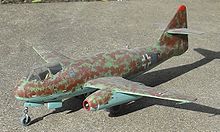Messerschmitt P. 1099
| Messerschmitt P. 1099 | |
|---|---|

|
|
| Type: | All-weather hunter |
| Design country: | |
| Manufacturer: | |
| Commissioning: |
Study 1945 |
The Messerschmitt P.1099 was a project by Messerschmitt AG .
Background information
The study carried out by Messerschmitt in the summer of 1943 initially envisaged further possible uses of the Messerschmitt Me 262 . Including versions as a high-speed bomber , reconnaissance aircraft, training aircraft and interceptor . In February 1944, these considerations led to the project P.1099. The P.1099 was to have an enlarged hull of the Me 262 and was to be used primarily against enemy bombers. Strong offensive armament was provided for this. After further study work on the project, the P.1099 was determined to be an all-weather heavy hunter. The planned sub-variants should only differ in terms of their changeable armament. In addition to a new fuselage, components of the support and tail unit of the Me 262 and its engine nacelles were to be taken over. Messerschmitt specified two pieces of military equipment.
Hunter I.
The Jäger I was planned with several smaller weapons and in three variants. Version A should have four MK 108 (30 mm). Variant B, on the other hand, has two MK 103 (30 mm) and finally the version C with two MK 108 and two MK 103. The armament should be closed in the hunter's bow.
Hunter II
The Jäger II was the projection of a heavily armed hunter, which was planned in two variants. Version A was to receive an MK 108 and an MK 112 (caliber 55 mm). Version B is an MK 114 with a 50 mm caliber.
The radio equipment consisted of a FuG 16 , the Peil G6, the radio altimeter FuG 101 , the radio landing device FuBl 2 and the enemy friend identification device FuG 25a . The project studies appear to have been completed in March 1944. The draft was taken up in the later Messerschmitt project Messerschmitt P.1100 and ended up in the Messerschmitt P.1101 .
Technical specifications
| Parameter | Herwig / Rode | Nowarra |
|---|---|---|
| crew | 2 | |
| length | 12.00 m | |
| span | 12.613 m | 12.61 m |
| height | 4,430 m | 4.40 m |
| Wing area | 22 m² | |
| Preparation mass | 5,061 kg | |
| Takeoff mass | 8,762 kg to 10,062 kg | 8,762 kg to 10,262 kg |
| Top speed | 805 km / h at 9100 m | 820 km / h |
| Service ceiling | 9810 m | k. A. |
| Range | 1340 km at 6000 m | k. A. |
| Engine | 2 × Junkers Jumo 004 C (2 × 1015 kp) | 2 × Jumo 004 C (2 × 1200 kp), later He S 011 A |
literature
- Heinz J. Nowarra : The German Air Armament 1933-1945. Volume 3, Bernard & Graefe Verlag, Koblenz 1993, ISBN 3-7637-5466-0 , p. 245.
- Dieter Herwig, Heinz Rode: Secret projects of the air force. Volume I, fighter aircraft 1939-1945, Motorbuch-Verlag, Stuttgart 2002, ISBN 3-613-02242-7 .
- Jean-Denis GG Lepage: Aircraft of the Luftwaffe 1935-1945. Mcfarland & Co Inc 2009, ISBN 978-0-7864-3937-9 .


